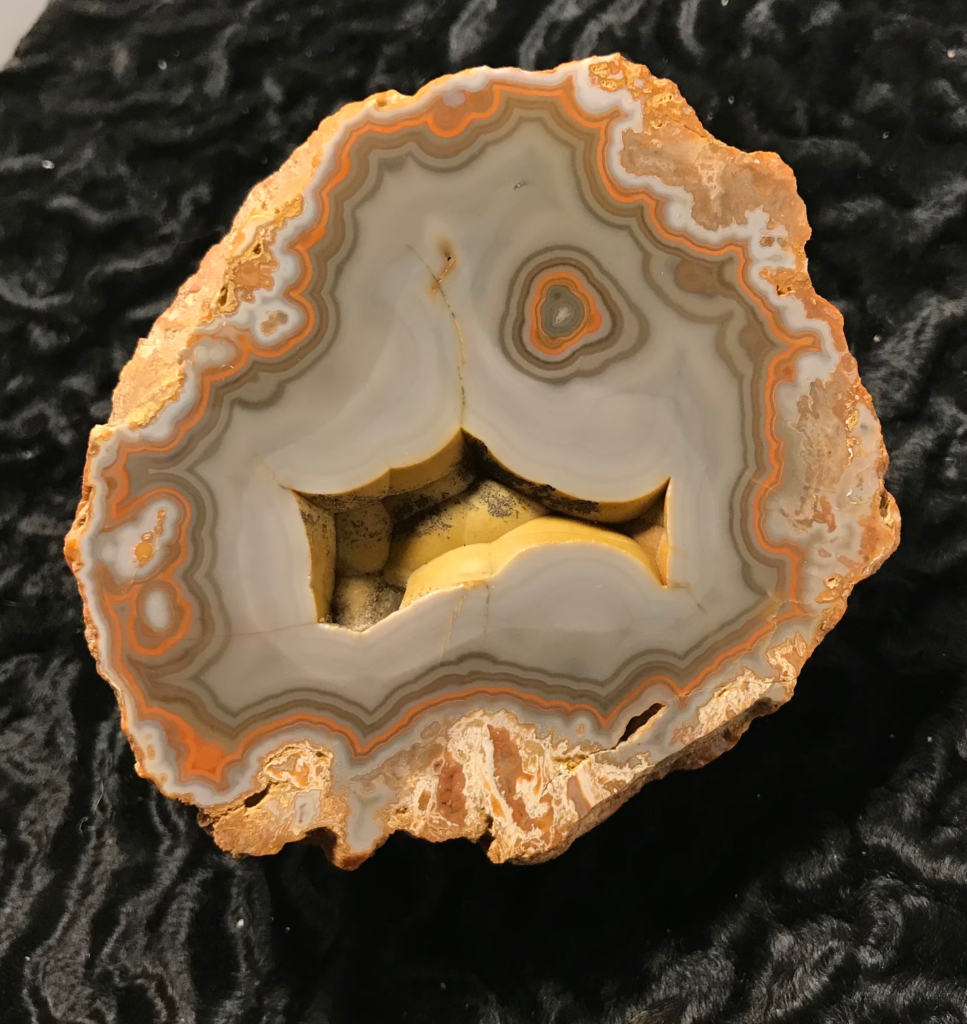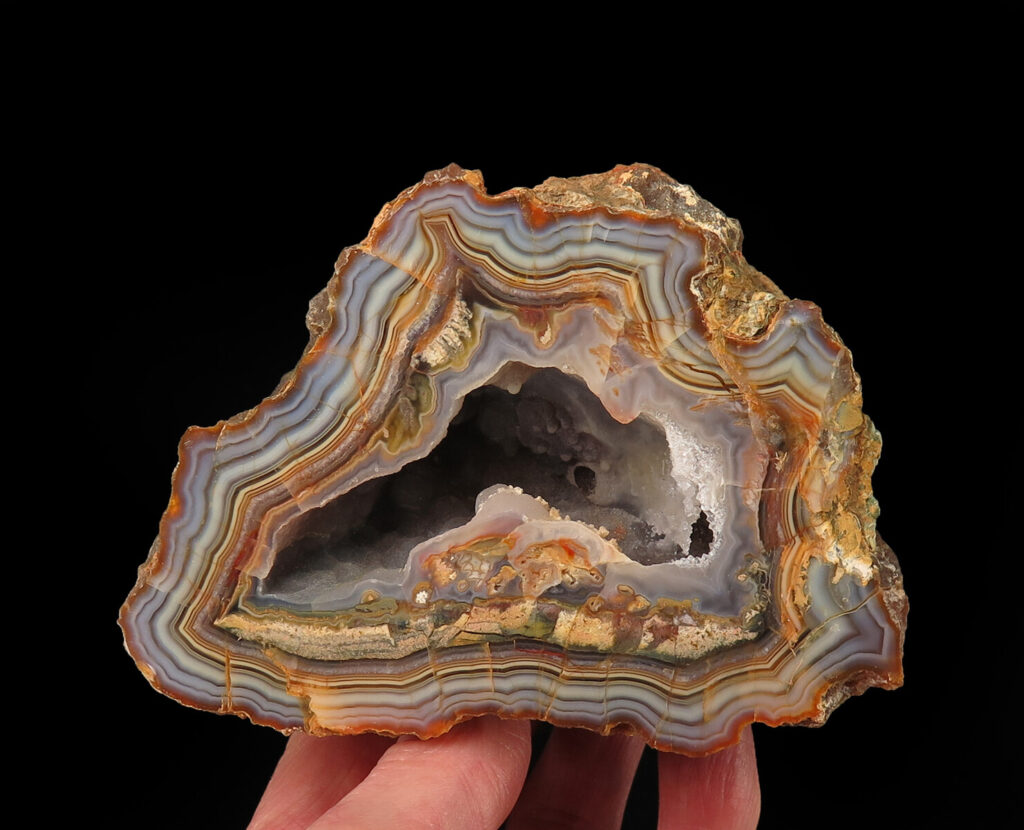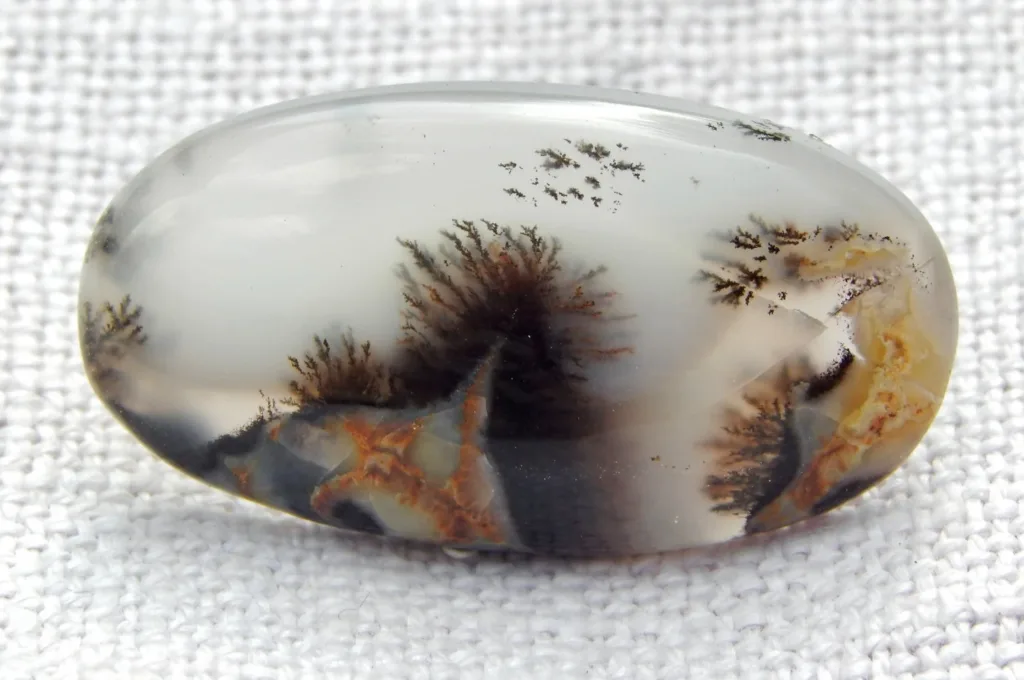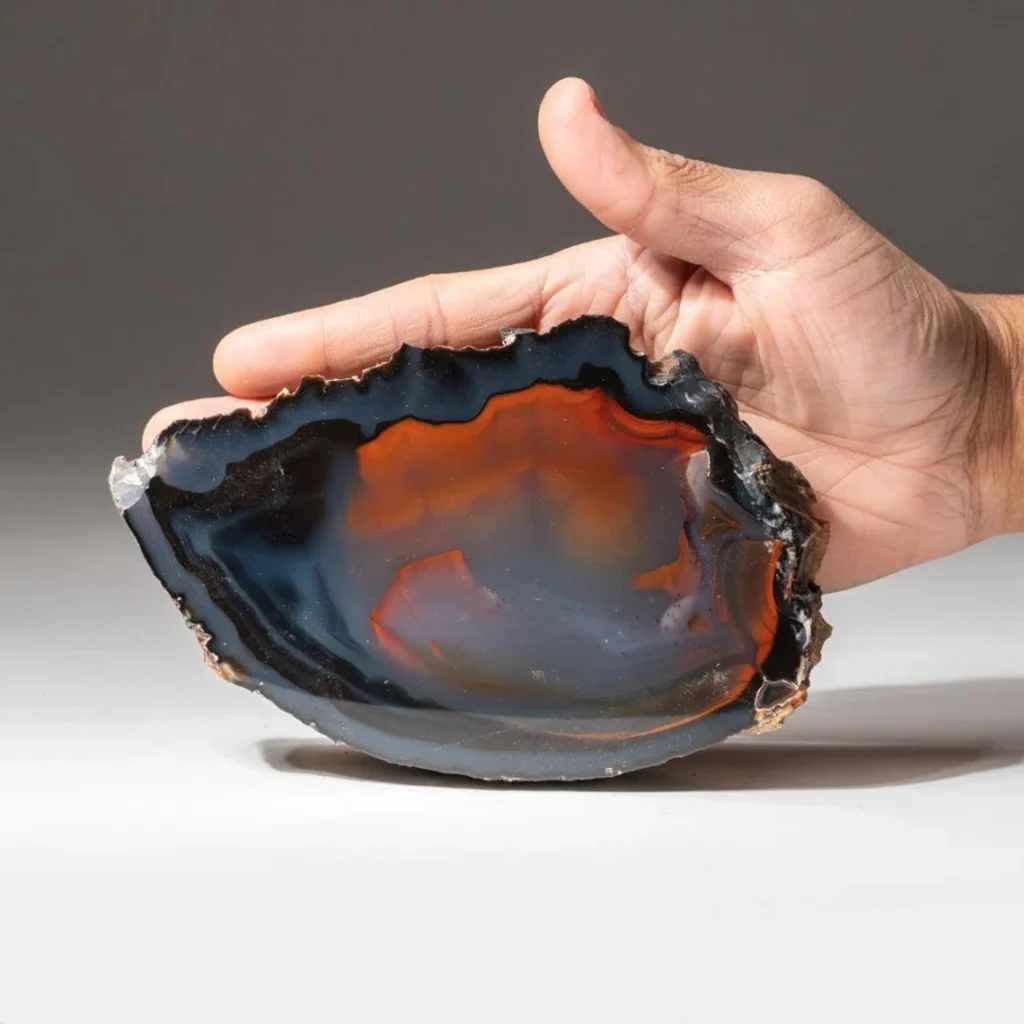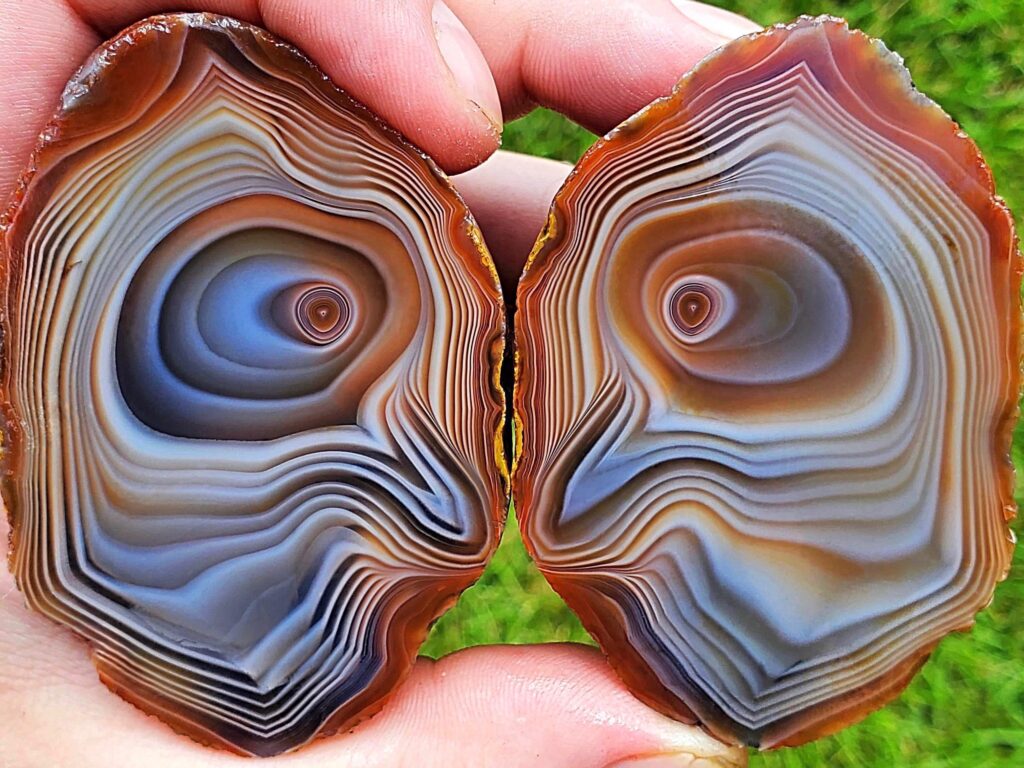Agate is a fascinating and versatile mineral that has captivated human interest for thousands of years. Agate is a variety of chalcedony, a mineral of the quartz family. It is distinguished by its fineness of grain and brightness of color. Agates are primarily formed within volcanic and metamorphic rocks. The colorful, banded patterns are created by the presence of impurities and occur in layers that follow the shape of the cavities in which the mineral forms. This layering makes agate highly distinctive and easy to identify.
The name “agate” is derived from the Achetes River in Sicily, where agates were found in ancient times. Historically, agates were highly prized among ancient civilizations. They were used not only as decorative gemstones but also in healing, as they were believed to ward off storms and bring favor in battles and trials. Agate artifacts, from jewelry to seal stones, have been found in archaeological digs dating back to the Bronze Age, showing the long-standing value and appeal of this mineral.
Importance in Geology and Gemology
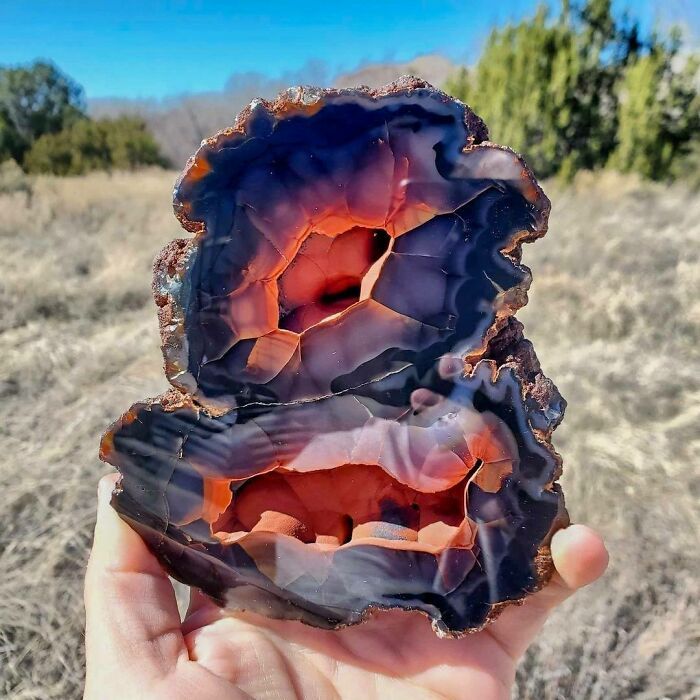
In geology, agate’s formation provides clues about the thermal history of the area where it is found. Its presence can indicate past volcanic activity and the conditions under which the rock formed. This makes agate an important mineral for geological studies, helping scientists understand the geological past and the environmental conditions that influenced rock formation.
In gemology, agate is valued for its aesthetic appeal and its physical properties. It has a hardness of about 7 on the Mohs scale, making it suitable for various uses in jewelry and ornamentation. The rich colors and intricate patterns of agate make it popular for both personal wear and decorative objects. Moreover, its diverse varieties, such as blue lace agate, moss agate, and fire agate, each have unique qualities and appearances, appealing to collectors and enthusiasts worldwide.
Agate’s combination of beauty, history, and utility continues to make it a cherished stone in both scientific and artistic communities.
Formation and Composition of Agate
Agate’s formation and composition are intriguing aspects that contribute to its varied appearance and wide distribution. Here is a detailed look at the geological processes involved, its chemical composition, and the types of deposits and locations where agate is found.
Geological Processes
Agate forms primarily as a secondary deposit in volcanic rocks, through the filling of cavities or vesicles. These cavities are often created by the escape of gases during the solidification of magma. Over time, silica-rich water percolates through these cavities. As the water evaporates, it leaves behind silica deposits that gradually build up to form agate.
This process can occur in multiple cycles, causing the characteristic banded patterns seen in many agates. Each band represents a separate episode of silica deposition, which may vary in color and opacity depending on the conditions at the time of deposition and the impurities present. Temperature fluctuations and changes in pressure can influence the formation process, leading to the diverse appearances of agate.
Chemical Composition
Agate is fundamentally composed of silicon dioxide (SiO₂), like all forms of quartz. However, what sets agate apart are the various impurities and trace elements that it contains, which can include iron, chromium, manganese, and nickel. These impurities are responsible for the rich colors and patterns found in agate. For example, iron compounds can give agate red, brown, or yellow hues, while manganese can result in pink or purple colors.
Types of Deposits and Locations
Agates are predominantly found in volcanic regions, but they can also occur in certain metamorphic rocks. They are typically found in geodes or as nodules in rock formations. A geode is a hollow rock inside which mineral materials such as agate have crystallized. Nodules, on the other hand, are more solid, rounded masses that are fully packed with crystallized mineral substances.
Notable locations for agate deposits include:
- United States: The Lake Superior region and the states of Oregon, Idaho, Washington, and Montana have extensive deposits of agate.
- Brazil: Known for large and colorful agates, Brazil is a major source of commercial agates, especially in the Rio Grande do Sul region.
- India: Agate is mined in the Gujarat state, particularly around the Khambat region.
- Germany: The Idar-Oberstein area has historically been a significant source of agate, though many of the local mines are now depleted.
- Mexico: Notable for varieties like Laguna agate and Crazy Lace agate, which are prized for their intricate banding and vibrant colors.
These varied locations highlight the widespread occurrence of agate and its global appeal, stemming from its fascinating formation process and striking natural beauty.
Types of Agate
Agate comes in an impressive variety of types, each distinguished by its unique color patterns, banding, and inclusions. Here’s an overview of some of the most popular and visually striking types of agate:
Blue Lace Agate
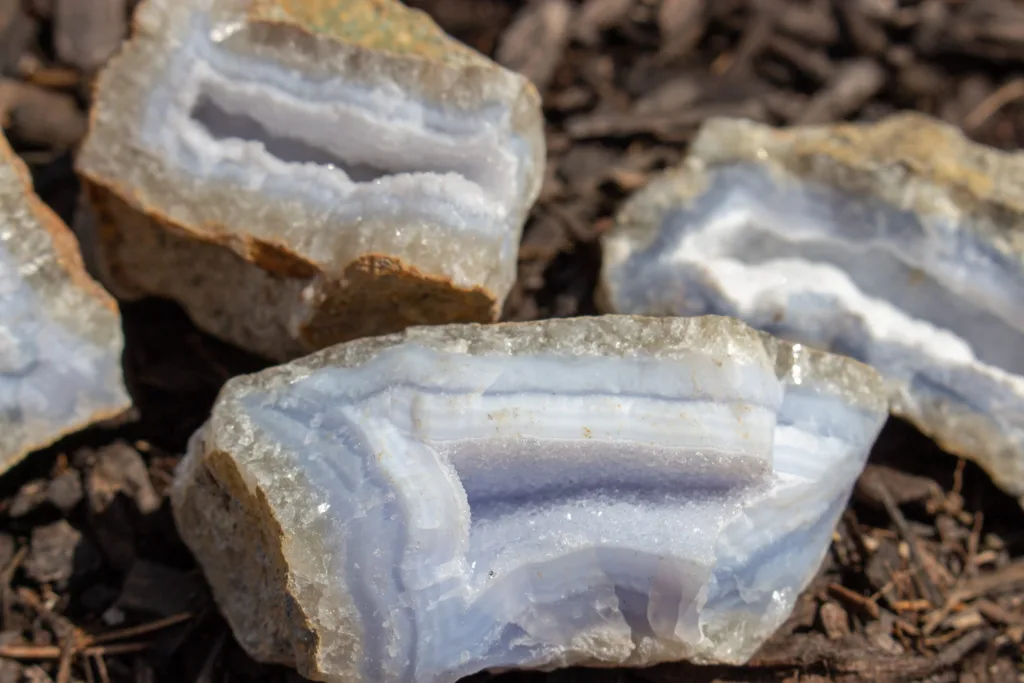
Known for its soft, blue bands, blue lace agate exhibits a delicate, lace-like pattern. It is often associated with calming qualities and is highly sought after in the gemstone market.
Moss Agate
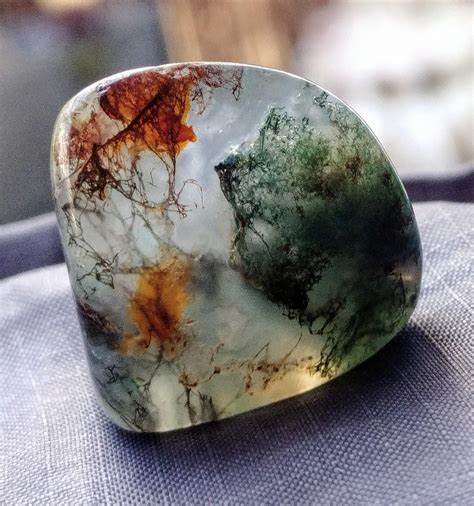
Unlike typical banded agates, moss agate does not have concentric banding but instead features green, moss-like inclusions of manganese or iron oxide. These are not actual moss but rather mineral features that resemble it, giving the stone an organic, earthy appearance.
Fire Agate
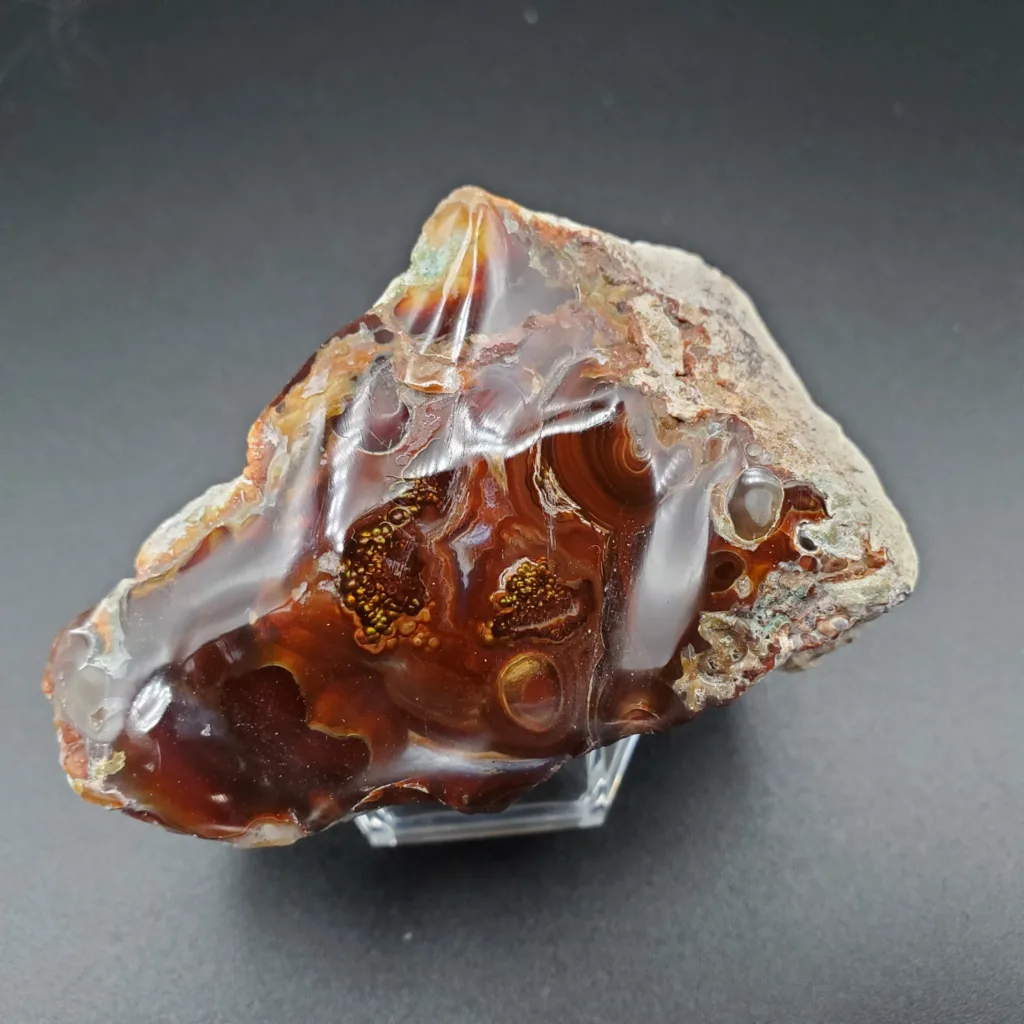
Fire agate is a rare type known for its iridescent colors that appear to glow with fiery inner depths. The colors shift with the light, showcasing vibrant reds, oranges, and greens due to its thin layers of iron oxide or limonite crystals.
Crazy Lace Agate
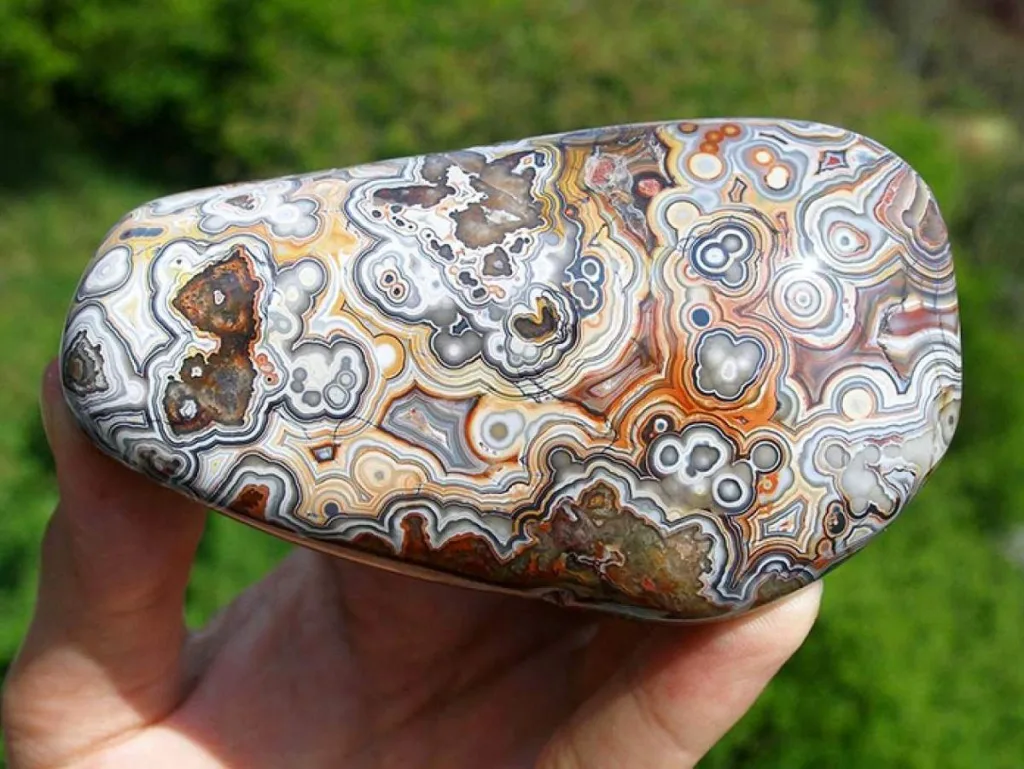
Characterized by a complex pattern of lines and swirls, crazy lace agate is a brightly colored and intricately patterned variety. Found predominantly in Mexico, this type is often multicolored with a predominance of red, orange, and yellow.
Dendritic Agate
This type features fern-like patterns created by manganese and iron oxides. Dendritic agate is prized for these unique, tree- or shrub-like inclusions, making each piece distinct.
Botswana Agate
Named after the region in Africa where it is mined, Botswana agate exhibits fine parallel lines with high contrast. It is often used in jewelry and is known for its protective qualities and ability to ward off spiders.
Laguna Agate
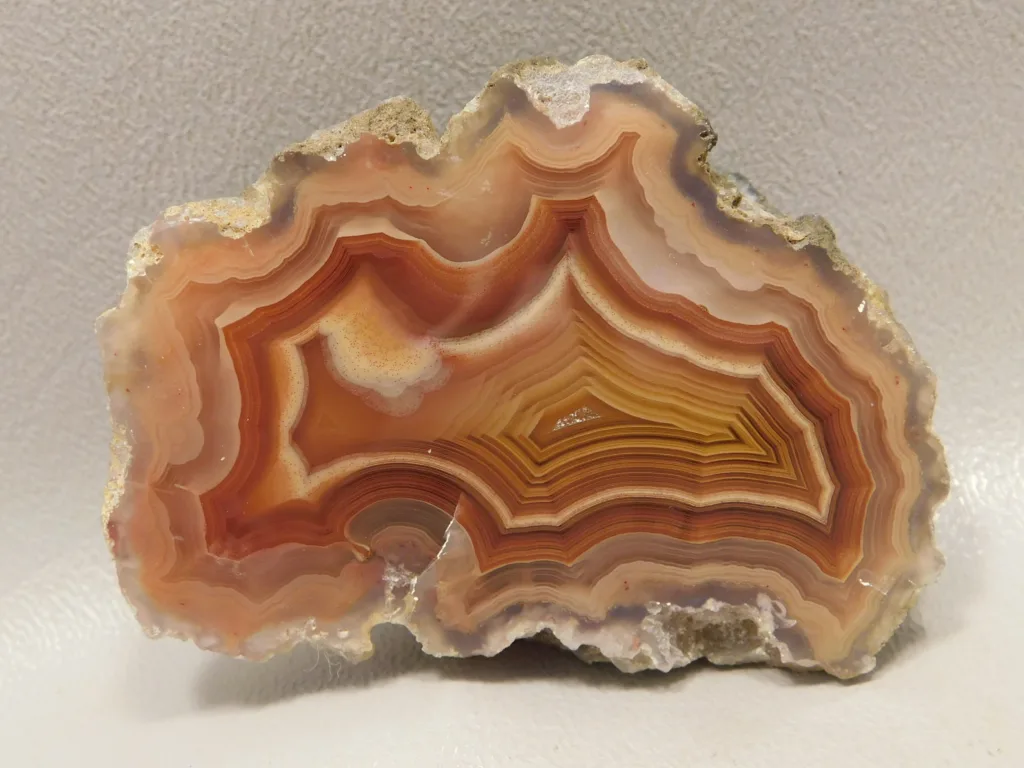
Laguna agate is renowned for its extremely thin, tight banding and a wide array of vibrant colors. It is one of the most prized agates and is sourced from the state of Chihuahua in Mexico.
Condor Agate
Originating from Argentina, Condor agate features vibrant natural colors and dramatic banding. It often has a glossy finish and is popular among collectors and jewelry makers.
Fortification Agate

This type resembles the aerial view of a fortress with its concentric lines following the shape of the cavity in which it formed. Fortification agate is common and widely appreciated for its geometrical precision.
Each type of agate has its own appeal and specific uses in jewelry, healing, and decorative arts, reflecting the diverse beauty and versatility of this gemstone.
Physical, Optical and Chemical Properties
Agate, as a variety of chalcedony and a member of the quartz family, boasts several intriguing physical, optical, and chemical properties that make it a popular choice among gemologists, jewelers, and collectors. Here’s a detailed breakdown:
Physical Properties
- Hardness: Agate has a hardness of about 7 on the Mohs scale, making it relatively hard and resistant to scratches. This property is crucial for its use in jewelry and other decorative items that require durability.
- Toughness: Despite its hardness, agate is also known for its toughness, which is the ability to resist breakage from mechanical stresses. This is due to its microcrystalline structure, where the tiny crystals interlock to provide strength.
- Density: Agate typically has a density ranging from 2.58 to 2.64 g/cm³, which is a typical range for quartz minerals.
- Porosity: Generally, agate is non-porous, which helps in its polishing and maintaining luster over time.
Optical Properties
- Transparency: Agate can range from translucent to opaque. Light can often filter through thinner slices of agate, showcasing its intricate patterns and color bands.
- Luster: When polished, agate exhibits a waxy to vitreous luster, contributing to its aesthetic appeal in jewelry and ornamental designs.
- Color and Banding: One of the most distinctive features of agate is its variety of natural colors and banding. The colors can include white, black, blue, red, green, yellow, and brown, often in layers or bands. These bands can be multicolored or single-colored, straight, wavy, or circular, depending on the environmental conditions during formation.
- Refractive Index: The refractive index of agate is typically around 1.544 to 1.553, which is consistent with other forms of quartz.
Chemical Properties
- Chemical Composition: Agate is primarily composed of silicon dioxide (SiO₂), the same chemical compound as pure quartz.
- Stability: It is chemically stable and resistant to most forms of chemical attack, though it can be affected by hydrofluoric acid.
- Solubility: Agate is generally insoluble in water and organic solvents but can dissolve in strong bases and hydrofluoric acid.
These properties make agate a versatile and durable material suitable for a range of applications, from fine jewelry and ornamental carvings to practical items like mortars and pestles. Its unique combination of beauty and resilience continues to make it a favored choice for both artistic and practical purposes.
Uses of Agate
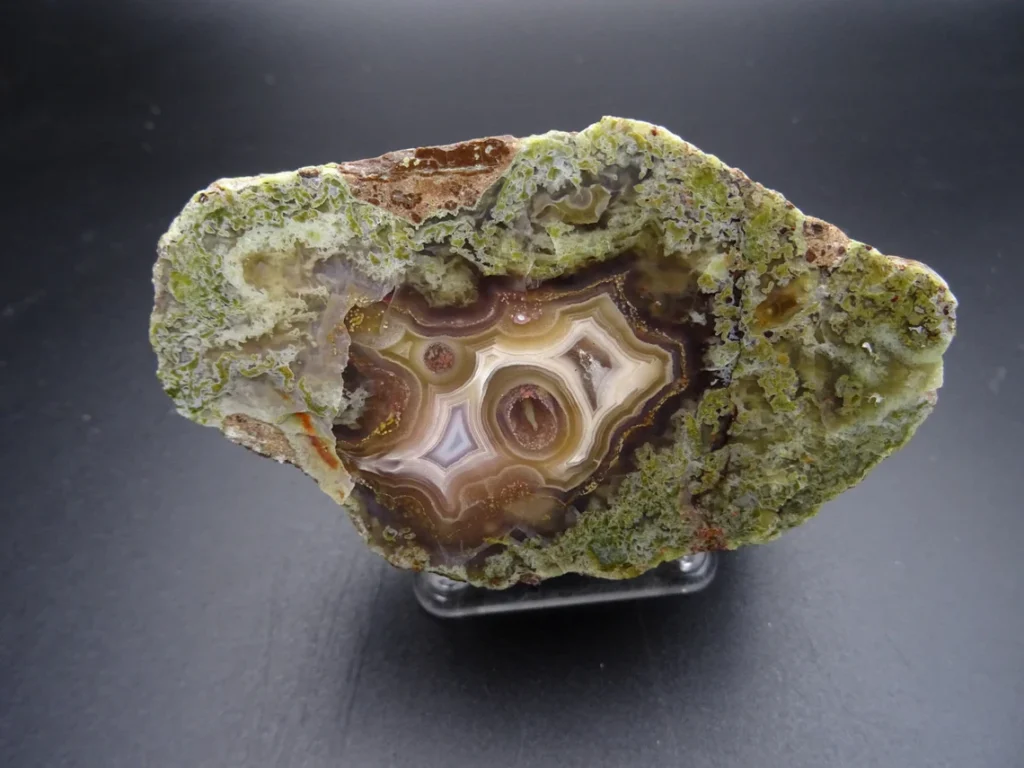
Agate, with its distinctive beauty and durable properties, has a wide array of uses spanning decorative, industrial, and metaphysical applications. Here’s a detailed look at some of the primary uses of agate:
Jewelry and Ornamental Uses
- Jewelry Making: Agate is extensively used in the jewelry industry due to its hardness and resistance to wear. It is fashioned into beads, cabochons, and other forms for necklaces, bracelets, earrings, and rings.
- Carvings and Sculptures: Its ability to be intricately carved and polished makes agate ideal for creating decorative sculptures, figures, and other ornamental objects.
- Home Decor: Slices of agate are often used as bookends, coasters, and tabletops. Larger cross-sections of agate can be used as wall decorations or insets in furniture.
Industrial Uses
- Precision Instruments: Agate is used in the manufacture of precision instruments such as levels, compass bearings, and for pivot points in balances because it can be finely ground and it withstands physical stress well.
- Mortars and Pestles: Due to its hardness and chemical resistance, agate is also used to make mortars and pestles for grinding chemicals and other substances in laboratories.
Spiritual and Healing Uses
- Crystal Therapy: Agate is popular in crystal healing, believed to promote emotional and physical balance and stability. Different types of agate are said to have specific properties; for example, blue lace agate is associated with stress relief, while moss agate is thought to encourage a connection with nature.
- Amulets and Talismans: Historically, agate has been used as a protective amulet, believed to ward off the evil eye and bring strength and courage to its wearer.
Artistic Uses
- Crafts and Accessories: Small pieces of agate are used in arts and crafts for making keychains, decorative boxes, and other small household items.
- Gemstone Mosaics and Inlays: Agate’s diverse colors and patterns make it suitable for creating intricate mosaics and inlays in furniture and artwork.
The combination of agate’s physical resilience and aesthetic appeal allows it to be used in a variety of contexts that capitalize on both its durability and beauty. Its historical and ongoing popularity in various cultures underscores its enduring appeal and versatility.
Agate in Culture and History

Agate has a rich presence in culture and history, playing a significant role in art, mythology, and commerce across various civilizations throughout the ages. Its appeal is timeless, evident from ancient artifacts to modern decorative uses. Here’s a deeper look into the cultural and historical significance of agate:
Ancient Civilizations
- Ancient Egypt: Agate was used in Egypt as early as 3,000 BCE for making seals, beads, and amulets, believed to offer protection and strength. The Egyptians also associated it with speech, making it a stone of diplomats.
- Greek and Roman Societies: The Greeks used agate to make jewelry and amulets from as early as the 3rd century BCE. The Romans valued it for its perceived medicinal and protective properties. They used agate rings for healing and saw the stone as a protector against natural disasters.
- Ancient Mesopotamia: Agate was a favorite in the ancient Mesopotamian region, used extensively for seal stones because its layers could be carved to create intricate intaglio work.
Medieval and Renaissance Periods
- Europe: Agate became a popular stone for the nobility in medieval Europe, often used in religious relics and as healing stones. It was believed to cure the stings of scorpions and the bites of snakes, as well as dispelling bad dreams and strengthening the body’s connection to the earth.
- Idar-Oberstein, Germany: This region became a hub for agate cutting and polishing from the 15th century onwards, known for its skilled artisans who developed innovative techniques that spread throughout Europe.
Eastern Cultures
- India: Agate has been used in India for millennia as a stone of protection, health, and prayer. Agate beads have been found in archaeological sites dating back to the Harappan civilization (around 3300–1300 BCE).
- China: Known as the “stone of balance,” agate was highly regarded in Chinese culture for its calming and healing properties. It was commonly used in the crafting of ornaments and sometimes grinding into powder for traditional medicines.
Symbolism and Folklore
- Victorian England: Agate was extremely popular during the Victorian era, often used in brooches and cameos. It was part of the Romanticism movement’s fascination with the natural world and the past.
- Native American Cultures: Various Native American tribes used agate for making tools, ornaments, and as a protective talisman. The stone was believed to have powerful spiritual properties, aiding in the search for truth and enlightenment.
Modern Uses and Symbolism
- Continued Craftsmanship: Modern artisans continue to cherish agate for its decorative potential and versatility. It remains a staple in jewelry and high-end decor.
- Metaphysical Properties: Today, agate is still revered in the metaphysical community. It’s believed to stabilize the aura, eliminate negativity, and inspire creativity and intellectual pursuits.
The historical and cultural journey of agate underscores its universal and enduring appeal. Whether used for artistic, practical, or spiritual purposes, agate’s presence in human history is a testament to its profound impact across time and cultures.
Famous Agate Locations

Agate, with its intricate patterns and colors, is found in various renowned locations worldwide. Each region often has a distinct type of agate associated with it, reflecting the unique geological conditions of the area. Here’s an overview of some of the most famous agate locations, notable mines, and the specific types for which these regions are known:
United States
- Montana: Known for the Montana agate, which features red and orange hues due to iron oxide. These agates are typically found in the alluvial gravels of the Yellowstone River and its tributaries.
- Oregon: Famous for the Oregon fire agate and blue agate, found in areas around the state, particularly in the high desert and volcanic regions. Fire agate from this region is prized for its brilliant iridescent colors.
- Michigan: The shores of Lake Superior are renowned for Lake Superior agates. These are richly colored and banded, formed as a result of volcanic activity around 1.1 billion years ago and are the official state gemstone.
Brazil
- Rio Grande do Sul: This region is a major global supplier of agates, which are mined from volcanic rocks. Brazilian agates are known for their large sizes and intense colors, often dyed to enhance their appearance for commercial purposes.
Germany
- Idar-Oberstein: Historically, this town was a hub for agate cutting and trading. The agates from this region are no longer abundant but were historically significant for the development of gem-cutting technology. The area now mostly works with imported agates.
India
- Gujarat: Specifically, the Khambat (or Cambay) region of Gujarat is known for its agate stone cutting and polishing industry. Agates here are typically used to make beads and other small artifacts.
Mexico
- Chihuahua: Home to the famous Laguna agate, known for its vivid color contrasts and fine banding. The mines in this region continue to produce some of the most sought-after agates in the world.
- Aguascalientes: Known for the Crazy Lace Agate, which features intricate swirling patterns of red, orange, yellow, and gray.
Argentina
- Patagonia: The region is known for Condor agates, which are admired for their vibrant colors and stunning patterns. These agates are found in the volcanic areas of Patagonia.
Australia
- Agate Creek: Located in Queensland, this area is famous for its agates with spectacular banding and colors, collected from streams and cut into beautiful gemstones.
Africa
- Botswana: Botswana agates are known for their fine bands and often display a wide range of colors, with pink and gray hues being particularly common. They are typically found in the country’s arid regions.
Historical and Modern Sources
Many of these locations have been historically significant for centuries, with some areas like Idar-Oberstein transitioning from local to imported agate processing due to depletion. Modern advancements in mining and gem processing continue to enhance the quality and availability of agates from these regions, making them accessible to a global market.
Each of these regions contributes uniquely to the diversity of agate available in the world today, reflecting the geological diversity and historical trade routes that have influenced the distribution and appreciation of this versatile mineral.
Agate FAQ
What is agate?
Agate is a variety of chalcedony, which is a mineral in the quartz group. It is known for its unique patterns and colors, which are created by impurities and mineral deposits that are present during its formation.
What colors does agate come in?
Agate comes in a wide range of colors, including white, gray, blue, green, red, orange, yellow, brown, and black. It can also have multiple colors in a single specimen, often arranged in bands or layers.
Where is agate found?
Agate is found in many locations around the world, including Brazil, Uruguay, Mexico, the United States, and Australia. It is typically found in volcanic rocks, such as basalt or rhyolite, where it fills cavities or voids in the rock.
What is agate used for?
Agate has several industrial and decorative uses, including jewelry, decorative objects, carvings and sculptures, industrial materials, and spiritual and healing practices.
How is agate formed?
Agate is formed through a process of precipitation from mineral-rich fluids, which can take millions of years. It is typically formed in volcanic rocks, where it fills cavities or voids in the rock.
What are the physical properties of agate?
Agate has a hardness of 7 on the Mohs scale, making it a relatively hard mineral. It has a vitreous to waxy luster, and a specific gravity of 2.6 to 2.7. It is also known for its banded appearance and translucent to opaque texture.
How is agate different from other types of quartz?
Agate is a variety of chalcedony, which is a microcrystalline form of quartz. It is distinguished from other types of quartz by its banded appearance and variety of colors and patterns, which are created by impurities and mineral deposits that are present during its formation.
Is agate a valuable gemstone?
Agate is a relatively common and affordable gemstone, although some specimens with rare colors or patterns can be more valuable. Its unique physical and optical properties make it a popular material for use in jewelry and decorative objects.


























